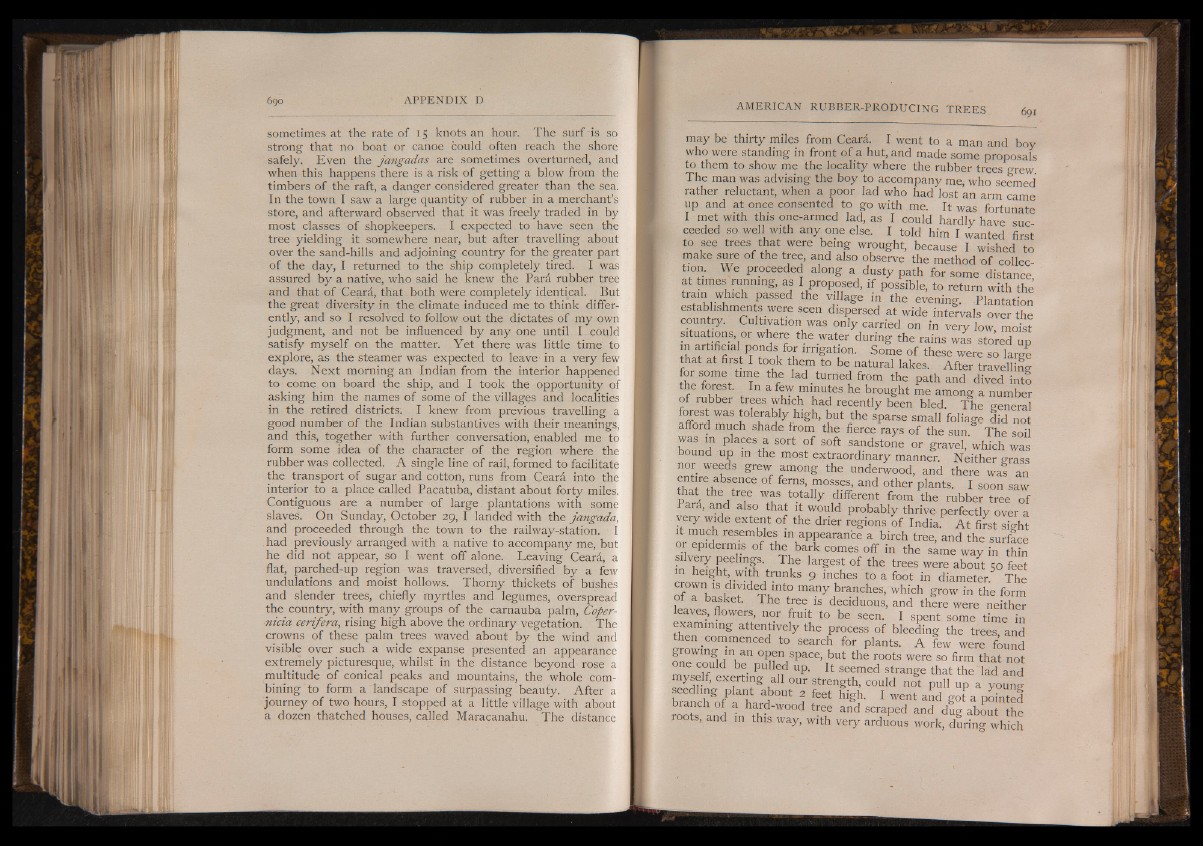
sometimes at the rate of 15 knots an hour. The surf is so
strong that no boat or canoe could often reach the shore
safely. Even the jangadas are sometimes overturned, and
when this happens there is a risk of getting a blow from the
timbers of the raft, a danger considered greater than the sea.
In the town I saw a large quantity of rubber in a merchant’s
store, and afterward observed that it was freely traded in by
most classes of shopkeepers. I expected to have seen the
tree yielding it somewhere near, but after travelling about
over the sand-hills and adjoining country for the greater part
of the day, I returned to the ship completely tired. I was
assured by a native, who said he knew the Para rubber tree
and that of Ceara, that both were completely identical. But
the great diversity in the climate induced me to think differently,
and so I resolved to follow out the dictates of my own
judgment, and not be influenced by any one until I could
satisfy myself on the matter. Yet there was little time to
explore, as the steamer was expected to leave' in a very few
days. Next morning an Indian from the interior happened
to come on board the ship, and I took the opportunity of
asking him the names of some of the villages and localities
in the retired districts. I knew from previous travelling a
good number of the Indian substantives with their meanings,
and this, together with further conversation, enabled me to
form some idea of the character of the region where the
rubber was collected. A single line of rail, formed to facilitate
the transport of sugar and cotton, runs from Ceard into the
interior to a place called Pacatuba, distant about forty miles.
Contiguous are a number of large plantations with some
slaves. On Sunday, October 29, I landed with the jangada,
and proceeded through the town to the railway-station. I
had previously arranged with a native to accompany me, but
he did not appear, so I went off alone. Leaving Ceard, a
flat, parched-up region was traversed, diversified by a few
undulations and moist hollows. Thorny thickets of bushes
and slender trees, chiefly myrtles and legumes, overspread
the country, with many groups of the carnauba palm, Coper-
■nicia cerifera, rising high above the ordinary vegetation. The
crowns of these palm trees waved about by the wind and
visible over such a wide expanse presented an appearance
extremely picturesque, whilst in the distance beyond rose a
multitude of conical peaks and mountains, the whole combining
to form a landscape of surpassing beauty. After a
journey of two hours, I stopped at a little village with about
a dozen thatched houses, called Maracanahu. The distance
may be thirty miles from Ceara. I went to a man and boy
who were standing in front of a hut, and made some proposals
to them to show me the locality where the rubber trees grew
The man was advising the boy to accompany me, who seemed
rather reluctant, when a poor lad who had lost an arm came
up and at once consented to go with me. It was fortunate
I met with this one-armed lad, as I could hardly have sue
eeeded so well with any one else. I told him I wanted first
to see trees that were being wrought, because I wished to
make sure of the tree, and also observe the method o f collection.
We proceeded along a dusty path for some distance
at times running, as I proposed, if possible, to return with the
train which passed the village in the evening. -Plantation
establishments^ were seen dispersed at wide intervals over the
country. Cultivation was only carried on in very low, moist
situations, or where the water during the rains was stored up
in artificial ponds for irrigation. Some of these were so large
that at first I took them to be natural lakes. After travelling
for some tune the lad _ turned from the path and dived into
the forest. In a few minutes he brought me among a number
of rubber trees which had recently been bled. The general
forest was tolerably high, but the sparse small foliage did not
afford much shade from the fierce rays of the sun. The soil
was in places a sort of soft sandstone or gravel, which was
bound up in the most extraordinary manner. Neither grass
nor weeds grew among the underwood, and there was an
T w ret1? f n°e ’ “ osses’ and other P^nts. I soon saw
that the tree was totally different from the rubber tree of
I ara, and also that it would probably thrive- perfectly over a
very wide extent of the drier regions of India. A t first sight
it much resembles in appearance a birch tree, and the surface
or epidermis -of the bark comes off in the same way in thin
silvery peelings. The largest of the trees were about 50 feet
in height, with trunks 9 inches to a foot in diameter. The
B i l l , r emunt° many ¡ M B l which grow in the form
of a basket. The tree is deciduous, and there were neither
leaves, flowers, nor fruit to be seen. I spent some time in
xaminmg attentively the process of bleeding the trees, and
then commenced to search for plants. A few were found
n l!Wml i nKan oPfn sPace, but the roots were so firm that not
mvseif H n Up' It: seemed strange that the lad and
j p l l ! exerbng all our strength, could not pull up a young
w m EH m m I feet hi^h- 1 went aad g * a d @ branch of a liard-wood tree and scraped and dug about the
roots, and in this way, with very arduous work, during which